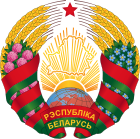
Belarus, officially the Republic of Belarus, is a landlocked country in Eastern Europe. It is bordered by Russia to the east and northeast, Ukraine to the south, Poland to the west, and Lithuania and Latvia to the northwest. Covering an area of 207,600 square kilometres (80,200 sq mi) and with a population of 9.1 million, Belarus is the 13th-largest and the 20th-most populous country in Europe. The country has a hemiboreal climate and is administratively divided into six regions. Minsk is the capital and largest city; it is administered separately as a city with special status.

Alexander Grigoryevich Lukashenko is a Belarusian politician who has been the president of Belarus since the office's establishment in 1994. This makes him the longest-serving European president.

The Byelorussian Soviet Socialist Republic, also known as Byelorussia, Belorussia, Belarusian SSR, Soviet Belarus, or simply Belarus, was a republic of the Soviet Union (USSR). It existed between 1920 and 1991 as one of fifteen constituent republics of the USSR, with its legislation from 1990 to 1991. The republic was ruled by the Communist Party of Byelorussia and was also referred to as Soviet Byelorussia or Soviet Belarus by some historians. Other names for Byelorussia included White Russia or White Russian Soviet Socialist Republic and Belorussian Soviet Socialist Republic.
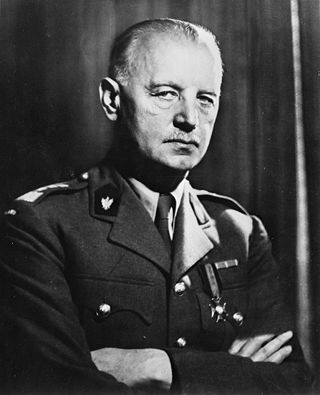
Władysław Eugeniusz Sikorski was a Polish military and political leader.

The state flag of Belarus is a red-green bicolour with a red-on-white ornament pattern placed at the hoist (staff) end. The current design was introduced in 2012 by the State Committee for Standardisation of the Republic of Belarus, and is adapted from a design approved in a May 1995 referendum. It is a modification of the 1951 flag used while the country was a republic of the Soviet Union. Changes made to the Soviet-era flag were the removal of communist symbols – the hammer and sickle and the red star – as well as the reversal of the colours in the ornament pattern. Since the 1995 referendum, several flags used by Belarusian government officials and agencies have been modelled on this national flag.
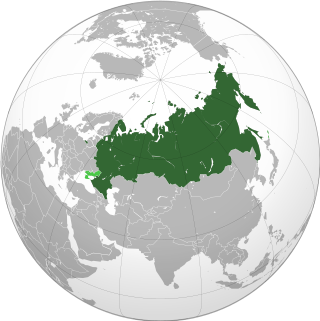
The Russian Federation is known to possess or have possessed three types of weapons of mass destruction: nuclear weapons, biological weapons, and chemical weapons. It is one of the five nuclear-weapon states recognized under the Treaty on the Non-Proliferation of Nuclear Weapons.

The Union State, or Union State of Russia and Belarus, is a supranational union consisting of Belarus and Russia, with the stated aim of deepening the relationship between the two states through integration in economic and defence policy. Originally, the Union State aimed to create a confederation; however, both countries currently retain their independence.
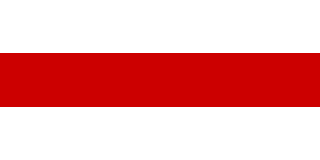
The Belarusian People's Republic, or Belarusian Democratic Republic, was a state proclaimed by the Council of the Belarusian Democratic Republic in its Second Constituent Charter on 9 March 1918 during World War I. The Council proclaimed the Belarusian Democratic Republic independent in its Third Constituent Charter on 25 March 1918 during the occupation of contemporary Belarus by the Imperial German Army.

During the existence of the Soviet Union, different governments existed within the Crimean Peninsula. From 1921 to 1936, the government in the Crimea was known as the Crimean Autonomous Socialist Soviet Republic and was an Autonomous Soviet Socialist Republic within the Russian Soviet Federative Socialist Republic (SFSR); from 1936 to 1945, the name was slightly altered to the Crimean Autonomous Soviet Socialist Republic.
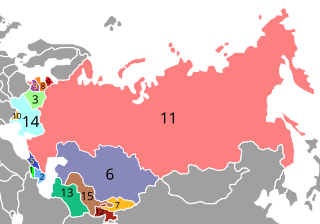
The post-Soviet states, also referred to as the former Soviet Union (FSU) or the former Soviet republics, are the independent sovereign states that emerged/re-emerged from the dissolution of the Soviet Union in 1991. Prior to their independence, they existed as Union Republics, which were the top-level constituents of the Soviet Union. There are 15 post-Soviet states in total: Armenia, Azerbaijan, Belarus, Estonia, Georgia, Kazakhstan, Kyrgyzstan, Latvia, Lithuania, Moldova, Russia, Tajikistan, Turkmenistan, Ukraine, and Uzbekistan. Each of these countries succeeded their respective Union Republics: the Armenian SSR, the Azerbaijan SSR, the Byelorussian SSR, the Estonian SSR, the Georgian SSR, the Kazakh SSR, the Kirghiz SSR, the Latvian SSR, the Lithuanian SSR, the Moldavian SSR, the Russian SFSR, the Tajik SSR, the Turkmen SSR, the Ukrainian SSR, and the Uzbek SSR. In Russia, the term "near abroad" is sometimes used to refer to the post-Soviet states other than Russia.
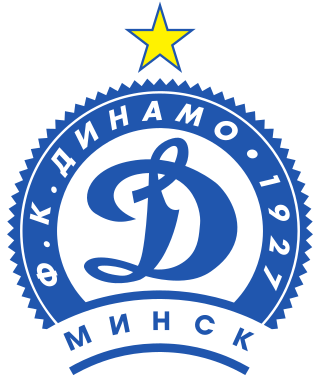
FC Dinamo Minsk is a Belarusian professional football club based in the capital city of Minsk.

The president of the Republic of Belarus is the head of state and head of government of Belarus. The office was created in 1994 with the passing of the Constitution of Belarus by the Supreme Council. This replaced the office of Chairman of the Supreme Council as the head of state. The tasks of the president include executing foreign and domestic policy, defending the rights and general welfare of citizens and residents, and upholding the Constitution. The president is mandated by the Constitution to serve as a leader in the social affairs of the country and to act as its main representative abroad. The duties, responsibilities and other transitional clauses dealing with the presidency are listed in Chapter Three, Articles 79 through 89, of the Constitution.
Union of Councils for Jews in the Former Soviet Union (UCSJ) is a non-governmental organization that reports on the human rights conditions in countries throughout Eastern Europe and Central Asia, exposing hate crimes and assisting communities in need. UCSJ uses grassroots-based monitoring and advocacy, as well as humanitarian aid, to protect the political and physical safety of Jewish people and other minorities in the region. UCSJ is based in Washington, D.C., and is linked to other organizations such as the Moscow Helsinki Group. It has offices in Russia and Ukraine and has a collegial relationship with human rights groups that were founded by the UCSJ in the countries of the former Soviet Union.
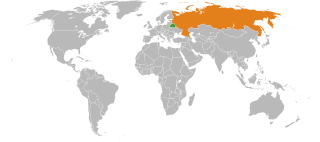
Belarus and Russia share a land border and constitute the supranational Union State. Several treaties have been concluded between the two nations bilaterally. Russia is Belarus' largest and most important economic and political partner. Both are members of various international organizations, including the Commonwealth of Independent States, the Eurasian Economic Union, the Collective Security Treaty Organization, and the United Nations.

The International Ice Hockey Federation is a worldwide governing body for ice hockey. It is based in Zurich, Switzerland, and has 82 member countries.

The Russian Soviet Federative Socialist Republic, previously known as the Russian Soviet Republic and the Russian Socialist Federative Soviet Republic, as well as being unofficially referred to as Soviet Russia, the Russian Federation, or simply Russia, was an independent federal socialist state from 1917 to 1922, and afterwards the largest and most populous constituent republic of the Soviet Union (USSR) from 1922 to 1991, until becoming a sovereign part of the Soviet Union with priority of Russian laws over Union-level legislation in 1990 and 1991, the last two years of the existence of the USSR. The Russian SFSR was composed of sixteen smaller constituent units of autonomous republics, five autonomous oblasts, ten autonomous okrugs, six krais and forty oblasts. Russians formed the largest ethnic group. The capital of the Russian SFSR and the USSR as a whole was Moscow and the other major urban centers included Leningrad, Stalingrad, Novosibirsk, Sverdlovsk, Gorky and Kuybyshev. It was the first socialist state in the world.

The Rada of the Belarusian National Republic was the governing body of the Belarusian Democratic Republic. Since 1919, the Rada BNR has been in exile where it has preserved its existence among the Belarusian diaspora as an advocacy group promoting support to Belarusian independence and democracy in Belarus among Western policymakers. As of 2024, the Rada BNR is the oldest existing government in exile.
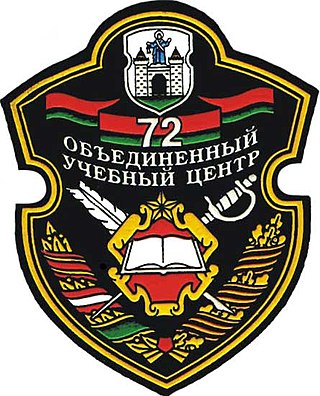
The 72nd Guards Joint Training Centre is a training centre of the Belarus Armed Forces. It trains warrant officers and junior specialists for the Belarus Armed Forces and is based in Borisov. The centre is currently led by Colonel Igor Korol. The 72nd Guards Joint Training Centre traces its history back to the Soviet 120th Rifle Division. For its actions during the Yelnya Offensive, the division became the 6th Guards Rifle Division in September 1941. In November 1945, the division became the 15th Guards Mechanized Division. On 15 May 1957, it became the 47th Guards Tank Division. The division became a training unit in 1960 and was renamed the 45th Guards Tank Training Division in 1965. In 1987, it became the 72nd Guards District Training Centre. In 1992, it was taken over by Belarus and became the 72nd Guards Joint Training Centre.
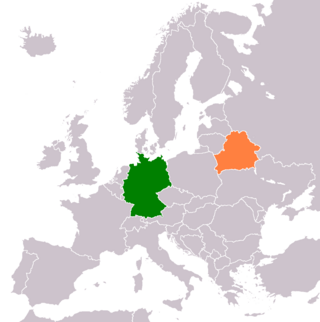
Germany has an embassy in Minsk. Belarus has an embassy in Berlin, a consulate general in Munich, and two honorary consulates in Cottbus and Hamburg.
